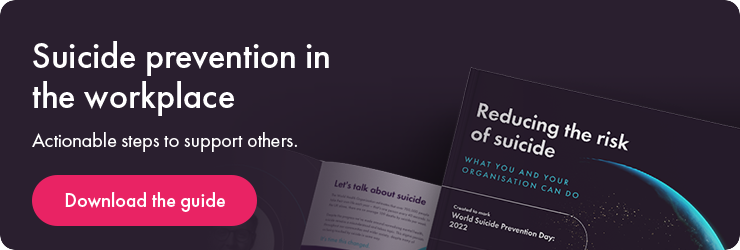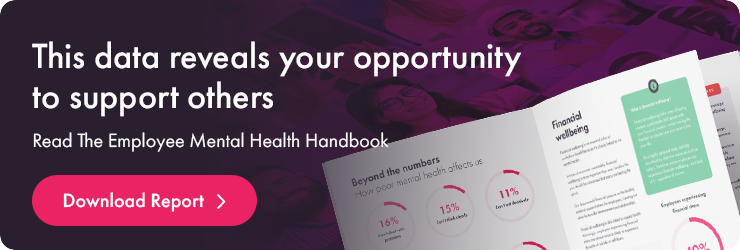Poor mental health is one of the most devastating issues facing UK organisations. But do you know how to spot mental health issues at work?
Worryingly, poor mental health in the workplace is extremely common, with 1 in 4 workers silently struggling.
As well as impacting the lives of employees, these issues are costly for UK businesses, as we summarise in this analysis of the cost of poor mental health at work.
Mental health conditions are also one of the leading causes of absence, with over 12% of employees taking days off as a result. The cost of presenteeism, where employees come to work even if they’re struggling, is even greater.
With so many people affected, knowing how to spot the signs of poor mental health in the workplace is a key skill to have as a leader, manager or colleague.
By familiarising yourself with the symptoms of poor mental health, you’ll be better able to support someone struggling.
In this guide, you’ll learn:
- What are the most common mental health issues at work?
- How to spot mental health issues at work
- How can employers make it easier to spot mental health issues?
- How to support an employee with their mental health
- What to do if an employee is experiencing suicidal thoughts
What are the most common mental health issues in the workplace?
The most common mental health issues in the workplace are anxiety, depression and stress.
Our employee wellbeing statistics revealed that 60% of working professionals experience at least mild symptoms of anxiety, and 1 in 4 meet the threshold for clinically relevant symptoms of anxiety.
Levels of depression are also high in the UK workforce, with 56% of individuals experiencing at least mild symptoms of depression and 25% reporting clinically relevant symptoms of depression.
Finally, 76% of employees surveyed are experiencing moderate to high levels of stress, with workload being the most frequently reported stressor at work.

How to spot mental health issues at work
Many of us are unfortunately still reluctant to disclose any mental health issues to managers or colleagues. This is often because we’re afraid of other people’s responses.
For this reason, everyone must take a proactive approach to the mental health of their colleagues and familiarise themselves with the common signs and symptoms of poor mental health.
These symptoms are not always obvious, but there are common signs to look out for. Here are 10 things to look out for when it comes to spotting mental health issues at work:
- Uncharacteristic behaviour
- Low levels of engagement
- Decreases in productivity
- Changes in sleeping or eating behaviours
- Disinterest in work or day-to-day activities
- Increased absence
- Changes in working patterns
- Withdrawal from social situations
- Irrational fears, paranoia or anxiety
- Substance use/misuse
If you notice any of these signs, it’s time to start the conversation. While they might not always be indicative of a mental health problem, it’s still important to find out. Read on for a more detailed look.
1. Uncharacteristic behaviour
You might notice that a team member doesn’t seem like their usual selves. For instance, they might start turning up late, acting aggressively or being unusually quiet.
2. Low levels of engagement
Low levels of engagement, lack of motivation and difficulty concentrating are not necessarily performance management problems – they can also be side effects of mental health issues.
3. Decreases in productivity
People who are experiencing poor mental health may appear disinterested, distracted or lethargic. They may also struggle to complete tasks and show an inability to make decisions.
4. Changes in sleeping or eating behaviours
Insomnia and difficulty sleeping are often potential indicators of a mental health issue.
You should also look out for employees who begin to regularly miss lunch or refuse to eat with co-workers.
Note: Concerned that a colleague is affected by an eating disorder? Learn more in this in-depth guide to eating disorders in the workplace.
5. Disinterest in work or day-to-day activities
A lack of interest in activities, particularly those that they used to enjoy, could be a sign of somebody experiencing low mood.
6. Increased absence
Taking regular, short-term absences for an ongoing problem may be reflective of an underlying mental health issue.
7. Changes in working patterns
Changes in working patterns, like frequently being absent, arriving late or leaving early, could all be indicators of an underlying mental health issue.
8. Irrational fears, paranoia or anxiety
Irrational fears and anxieties are typical of some mental illnesses. Examples include paranoia about co-workers and anxieties around job security.
9. Withdrawal from social situations
Employees may start to withdraw into themselves and isolate themselves from colleagues. Many people with mental health concerns suffer from isolation, loneliness and self-loathing.
10. Substance use/misuse
To self-medicate, employees may turn to alcohol, drugs or other addictions. This is typically an urgent sign that your employee needs help.
How can employers make it easier to spot mental health issues?
For managers, identifying employees who may be experiencing mental health issues can be extremely difficult, especially if the working environment is not conducive to people opening up about their mental health.
Follow the steps below to develop an open environment, in which it will be easier to talk to and support anyone experiencing poor mental health.
1. Be available
Maintain an open and meaningful dialogue with your employees around mental health. Make it clear to your employees that you are always available for a conversation and support.
2. Make confidentiality clear
We recently analysed a report asking the question: are remote mental health services effective?
We found that one of the key concerns for people using remote mental health services was confidentiality. This may particularly be the case when they are discussing private issues such as financial wellbeing.
With that in mind, make it clear to your team that any discussions with you will be kept as private as possible.
3. Start the conversation
Take the initiative, and regularly check in on the mental health of your team. If possible, do this in a one-to-one setting.
For more guidance on how to discuss employee mental health, read this guide on Talking About Mental Health in a Staff Appraisal or 1:1 or watch the video below.
4. Involve your employees
You don’t have to take the burden all on yourself. Encourage your team to speak openly about mental health and to look out for each other.
5. Utilise a check-in scale
People may not always be willing to discuss their mental health, particularly in a group setting. Asking employees which image they resonate with on a check-in scale may create an easier way for them to open up.
6. Ask twice
Three in four people would say they’re fine even if they’re struggling, so ask your employees how they’re doing – twice.
Simply asking again, with interest, might just lead to your employee disclosing an issue they otherwise would have kept hidden.
7. Show compassion and empathy
If your employees do approach you, there’s no substitute for demonstrating compassion and empathy throughout the conversation.
Being able to understand where someone is coming from, and following up with them after the meeting, can mean the world to that team member.
8. Lead by example
Your team will be more likely to open up if you express your own vulnerabilities. If you feel comfortable doing so, talk about any mental health struggles you might have faced.
How to support an employee with their mental health
Just as mental illnesses can be extremely daunting for those who are facing them, it may also feel daunting for you wanting to help them.
If you think one of your team is struggling, or you find out that an employee is experiencing poor mental health, it can sometimes be difficult to know what to do.
Use the five steps below and you’ll put yourself in a strong position to help your employees.
1. Start the conversation
Talk to your employee about the problems they’re experiencing. Ask simple, open and non-judgmental questions and let them explain in their own words how their mental health affects them and what support they need.
For help with these conversations, read our guide on how to talk about mental health at work.
2. Make the necessary adjustments
Once you’ve started the conversation with a struggling employee, it’s time to figure out how you’ll support them. Consult your workplace policies to determine the adjustments you could make to address their mental health difficulties.
3. Don’t put too much pressure on yourself
While it is your responsibility to support the wellbeing of their employees, you are not expected to be an expert, or to have all the answers. Don’t put too much pressure on yourself.
4. Educate yourself
Make use of resources that can educate you on how to help employees experiencing different mental health issues.
For instance, to find out more about how you can support the 1 in 3 workers affected by stress, read our guide on helping employees manage stress.
5. Encourage your employees to access their support network
As an employer, there is only so much you can do. It is essential that your employees can rely on their support network for help as well.
Encourage them to fill out a wellbeing support grid, which will give them a feel for the strength of their support network.
6. Signpost to other services
If you feel that your employee requires help beyond what you can offer, signpost them towards other services.
These could be internal services, such as an EAP, or external services. Samaritans, Mind and Rethink Mental Illness are all excellent external charities to recommend for professional support.
What should you do if an employee is experiencing suicidal thoughts?
If an employee is experiencing suicidal thoughts, then recognising the warning signs, asking the right questions and knowing what help to offer is critical.
Read our suicide prevention guide to find out the actionable steps that you can take to support those who are struggling – whether they work with you or not.
When approaching a colleague who you believe may be experiencing suicidal thoughts, follow the CLASS approach for supporting colleagues in crisis.
You can make a huge difference
Learning how to spot mental health issues at work is not always easy, but it’s so important.
As an employer, manager, or colleague it’s your responsibility to be on the lookout for any member of your team who may be experiencing mental health issues.
Even if you cannot directly help them, you can always point them in the direction of someone who can.
Getting started is often the hardest part, so the first things to do are to familiarise yourself with the signs and symptoms of mental illness in the workplace and get talking with your team.
If you’re able to do this, then you could make a huge and potentially life-changing difference to the lives of your employees.








